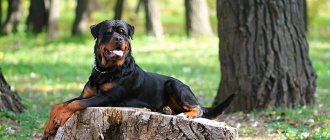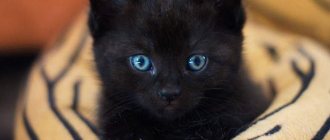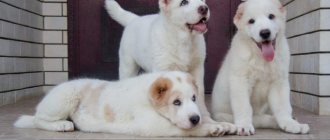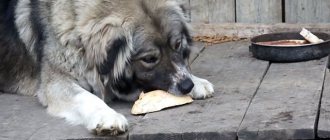The size and physiological maturation of animals depend on a large number of different factors. To know exactly to what age cats grow, it is necessary to take into account their breed, the functioning of the endocrine glands and their general health. Proper care and the creation of suitable conditions can affect the growth of a pet.
How old do cats grow?
Height in cats is a relative concept. With age, they may become larger in both length and width, depending on the breed. And not only this affects the growth rate of a pet. Physical activity, diet, and general health all play a role here. Of course, there are average indicators that can be used to roughly determine at what age a pet will reach its maximum size. But they are different for each breed.
Scots
Among the Scots, one can distinguish lop-eared and straight-eared representatives. If we look at the general characteristics of the breed, we can see that by the age of three, cats’ muscle mass, skeleton, as well as eye color and coat color are finally formed.
Fold
Scottish Fold kittens are born weighing from 60 to 140 grams. It all depends on the number of brothers and sisters. In the first two weeks, the weight gain will be small and will not exceed 20 grams. In the future, growth will go faster, the main thing is to ensure that the kitten receives a sufficient amount of mother's milk. By two months, his weight should reach 1.5 kg, and by six months, up to 3 kg.
Scottish Folds develop to their maximum by the age of three. The weight of an adult male can reach 6.5 kg, and females 4.5 kg. By that time, they are already fully physically developed and ready to reproduce.
Straight-eared
Representatives of straight-eared Scots are somewhat larger than their fold-eared counterparts. Their growth rates are not much different, but their final weight is yes. Males by the time of their final development reach 7 kg in weight, while females can weigh 6 kg. This is due not only to nutrition. Genetics plays a big role here. Straight-eared Scots rarely have deviations in terms of height. And if the cat is also a purebred, then we can safely say that he will grow into a fat teddy.
British
The British begin to actively grow already at the age of one month. By then, their teeth have formed and they can eat on their own. Since, due to the characteristics of the breed, these felines are prone to obesity, their diet should be given increased attention.
Their musculoskeletal mass is finally formed by 2-2.5 years of life. But even after this they can continue to develop, until they reach the age of three. The weight of an adult male can reach 8 kg, and a female 6 kg. If you add two kilograms to each indicator, you can get the weight that these representatives of the feline family can gain after castration or sterilization.
Regular cats
Cats and male cats without claims to purebred also have their own developmental characteristics. As a rule, they reach the bulk and growth by two years. As mentioned earlier, a lot depends on heredity, nutrition and lifestyle. Sedentary animals that prefer to spend most of their time lying on the sofa can reach a weight of up to 9 kg. Moreover, these can be both males and females. Especially when it comes to castrated or sterilized cats.
In the latter case, special attention must be paid to nutrition. It will be better if you feed the animal with special dietary foods that have a balanced combination of nutritional components and are easily absorbed by the body.
Maine Coon
There is a misconception that adult Maine Coons can reach up to 15 and even 25 kg in weight. However, despite the large growth (up to 100 cm in length) of the animal, the weight of an adult male does not exceed 12 kg, and the female is even less - 8 kg. They are born larger than kittens of other breeds: babies can weigh from 120 to 140 grams. And this only happens if there are several kittens in the litter. If the baby was born alone, his weight may be 160 grams.
Maine Coons grow up to three years old, like most purebred cats. Closer to this age, their muscles actively develop: their chest becomes wider, and their shoulders and paws become stronger.
Bengal
Bengal babies weigh from 70 to 120 grams at birth. They grow actively until 9 months, after which the rate of their development decreases. In females at this age it can generally stop, while males can grow up to two years.
The maximum weight of females does not exceed 5 kg, males - 8 kg. And the body length can vary from 50 cm to 1 meter.
Sphinxes
Sphynx kittens are born tiny and helpless. Their birth weight is only 85 grams. But at the same time, after three days they are able to independently find their mother’s nipple and, with the movement of their paws, cause the release of milk. Sphynx cats are considered one of the smartest cats.
Who is it suitable for?
The British cat is often called the pet of businessmen. These people are always busy and are away from home for a long time. At the same time, the cat does not become depressed, does not suffer from loneliness, and always finds something to do. And when the owner returns, he rushes to greet him. When going out to work, you can see her looking out the window and following her with her gaze. Such a loyal, devoted friend. The cat likes to sit next to the owner, watch a movie with him, and watch work. Unobtrusive, clean, intelligent by nature. They love to be petted.
The British are suitable for those who live alone. Their appearance and intelligent look give the impression that they understand all the problems. You can share thoughts with a cat, consult, talk. This is a balm for loneliness. If you bring her into a family, she will find a common language with everyone, but will only be attached to those family members who show her affection.
Attitude towards the owner
Cats with a strong sense of duty. They always become attached to the person who cares about them the most, and most importantly, feeds them. Comes to the owner to sit next to him or on his lap. Understands his commands, listens, but often does what he considers necessary. Shows his feelings hidden. But he always greets you from work with a kind look and sees you off with sadness in his eyes. This is the type of cat that will never betray, does not run from one hand to another. Only trusted people allow themselves to be petted. Does not approach strangers closer than 2 meters. When trying to approach her, she quickly runs away and hides.
The cat always makes it clear to be picked up and stroked. Most of the time he just prefers to be nearby.
Relationships with children
It is better not to have a British cat as a toy. Patient, self-possessed, disciplined, non-aggressive. It will not harm the child. Will not tolerate squeezing or excessive squeezing. She will not feel comfortable with a small child. He will constantly run away and hide. Gets along very well with older children. Attached more firmly than to adults if treated appropriately.
Interaction with other animals
The British cat gets along well with other pets, even other cats. But he can always stand up for himself in the event of an attack. Doesn't show initial aggression or hostility.
To what age do domestic cats and cats of different breeds grow?
The size and physiological maturation of animals depend on a large number of different factors. To know exactly to what age cats grow, it is necessary to take into account their breed, the functioning of the endocrine glands and their general health. Proper care and the creation of suitable conditions can affect the growth of a pet.
Price
The cost of a British Shorthair cat is small and depends on the class. Animals that are not suitable for breeding and exhibition are cheaper. Therefore, if your goal is to buy a pet, then feel free to choose a pet-class cat. Its cost will be about 100-150 dollars. Breed and show class cats are more expensive - about 500-700 dollars.
Be sure to purchase a cat from a trusted cattery. A low price may be a reason to doubt the integrity of the seller, so focus on the average price on the market.
Age at which cats grow
Full physiological maturation of the animal occurs with puberty. However, growth continues for some time. The average age at which cats stop growing is from 1 to 3 years. The exact time depends on several internal and external factors, including the characteristics of the content and breed. Height does not include obesity.
There are 5 stages of cat maturation:
- Neonatal - from birth to 4 days. At this time, the kitten’s weight either increases or decreases.
- Suction - from 5 days to 1 month. The animal is actively growing and developing.
- Transitional - from 1 to 1.5 months. During this period, growth slows down somewhat. New products are being introduced to the pet's menu.
- Adolescence - from 4 months to 1 year, when growth is activated again and continues until full puberty, that is, readiness for reproduction.
Starting from 1 year, the cat is considered independent.
Factors affecting dimensions
The growth and maturation of a cat is influenced by external factors and features of physiological development. These include:
- Breed is one of the most important factors affecting the height and weight of an adult animal, as well as the age at which it reaches adulthood. In outbred domestic cats, the genotype is most often mixed, so it is unlikely that it will be possible to determine the exact timing of development. Some kittens grow up to 3 years old, while others reach their maximum height and weight by one year.
- Heredity - the size of an animal largely depends on the size of its parents. It is extremely rare for small cats to give birth to large kittens.
- Gender of the animal - males always grow larger and heavier than females.
- Living conditions - growth is influenced by a comfortable room temperature, sufficient light, good restful sleep and the baby’s nutrition.
- State of health and presence of any diseases. The pathology can be any - somatic, infectious, parasitic or genetically determined. The correct functioning of the endocrine glands is also important.
- Physical activity and lifestyle - the more a kitten moves and plays, the better it grows. His body develops proportionally, and his weight is normal for his age and breed.
- Castration, especially performed in adulthood. Cats that are sterilized at the age of 2-3 years and older grow larger than those that were neutered before a year or were not sterilized at all.
Early mating before the age of 1 year leads to a slowdown or complete cessation of the animal’s growth.
Causes of delayed development
It often happens that a cat lags behind the growth standards inherent in its age and breed. There are several reasons for this phenomenon:
- Wrong diet. If a kitten’s menu lacks vitamins, protein and microelements, the animal will gain weight poorly and lag behind in physiological development.
- Diseases - these can be bacterial and viral infections, autoimmune and hereditary conditions.
- Congenital or acquired hormonal disorders. The most common cause of slow growth is sterilization too early. This operation leads to a change in the hormonal background of the animal, and, as a result, to a change in metabolism. Gradually the animal's condition is restored, but this takes more time. Other endocrine causes may include adrenal or thyroid disease.
- Helminthiasis is infection by parasites. If worms or other parasites appear in the animal's intestines, they deprive the kitten of a significant part of its nutrients. As a result, growth and development slows down.
- Prolonged stay at low ambient temperatures. It has been noticed that in the cold season pets grow more slowly. The optimal air temperature for good development is 22...25 °C.
Dependence on breed
The age at which a cat grows largely depends on the breed .
British cats are especially popular among pet lovers. This breed is distinguished by a short, bluish-gray coat that resembles a plush one. The expression on their faces can be very funny, and their disposition can be light and affectionate.
Females of this breed gain weight up to 6 kg, and after sterilization they can grow up to 8 kg. An adult British cat gains up to 8 kg of body weight, and after castration, up to 10 kg. The age at which British cats grow is 3 years; in female cats, maturation occurs faster - by 1.5 years. If pregnancy occurs, growth is interrupted during this time, but then the female makes up for the lack of weight.
The Scots have growth parameters and development periods that coincide with the British. But Scottish kittens have a more balanced character.
In sphinxes, puberty begins early. Cats can stop growing as early as 5-6 months, at which time they can become pregnant. Sphynx cats grow until about 2.5 years of age. An adult cat can weigh from 2 to 4 kg, and a male cat can weigh from 4 to 6 kg. The breed is prone to overeating and gaining excess weight. This is easy to identify by body shape, since sphinxes do not grow hair. It is very important to monitor their diet.
Tips for maintaining normal weight
To keep a British cat's weight within normal limits, owners need to maintain a balanced diet:
- add a small percentage of cereals and vegetables to dry and soft food;
- add boiled vegetables to the food (various varieties of cabbage, beets);
- meat and fish should only be lean, they should be included in the menu daily;
- Among the cereal products, it is best to give your cat oatmeal, millet, and rice;
- You need to cook porridge for your pet in water, without adding sugar and salt.
A kitten is taught to eat cereals and vegetables from an early age. The diet of an adult British cat should consist of 10–15% vegetables and cereals, 85–90% meat and fish.
Also, we must not forget about regular physical activity. To prevent a cat from developing obesity, the owner must engage it in active games every day.
High-quality and balanced nutrition, an abundance of vitamins and nutrients, an active lifestyle - these are the main factors for the full development of a British pet.
The owner should weigh the kitten at the same time every day in order to notice weight deviations in time. If the development of the “British” does not correspond to his age, then there is no need to hesitate in going to the veterinarian.
Source
Content recommendations
The answer to the question of how long cats grow depends largely on proper care. Owners need to create the most suitable conditions for their pets. First of all you need to:
- Maintaining hygiene is no less important for cats than for people. The pet must always be clean and well-groomed. Once a month, the cat needs to be bathed and thoroughly brushed. The cat's litter box should be emptied regularly and the filling should be changed, and the food bowl should be thoroughly washed several times a week.
- Once a quarter, helminthiasis prevention should be carried out. This is done with the help of special drugs. You can find out the exact name and dosage from your doctor.
- If the animal suffers from any chronic disease, it is necessary to regularly see the veterinarian. Take courses of treatment or prevention as prescribed.
- Comprehensive vaccinations against feline infections need to be updated annually. Thanks to this measure, the cat’s risk of contracting a viral, bacterial or fungal infection is reduced. This also applies to pets who do not leave the apartment. Owners can bring the infectious agent on shoes or clothing.
- Proper nutrition plays an important role. There are special cat foods with vitamin and mineral supplements on sale. If the animal eats natural products, medications are purchased separately.
- You should not expose your cat to unnecessary stress - yell at him, physically punish him, etc. Jealousy has a bad effect on the animal’s psyche.
- Early mating will not benefit the cat's health. If a pet becomes pregnant before a year, she may experience hormonal imbalances and developmental arrest. The female’s body will devote all its strength to bearing offspring, and the cat herself may become seriously ill or die from exhaustion.
Compliance with these conditions will help raise a healthy and strong animal that will delight the owner for many years.
Castration and sterilization
If the animal will not participate in mating, and the owner does not want to produce offspring, then it is worth doing the procedure of sterilization or castration. It will protect the pet’s health and prevent accidental mating. It is recommended to castrate and sterilize individuals who were born in marriage or have genetic diseases.
The operation is allowed to be carried out at 8-10 months, when the animal’s body is fully formed. Before the operation, it is important to examine the British person, since deviations in health can lead to complications.
Caring for your pet after surgery
After surgery, your pet will need special care that will reduce the risk of complications.
For several days after surgery it is recommended:
- limit the animal's mobility;
- provide comfort;
- do not frighten or torment your pet;
- do not feed for 10 hours after anesthesia;
- put on a special device to maintain the seams;
- treat seams once a day for 14 days.
If a Briton feels unwell, the stitches begin to get wet, the temperature rises, etc., then he must be taken to the clinic immediately.
Examples to what age cats can grow
When answering the question of how long cats grow, you should pay attention to the breed. Growth implies not only an increase in the external size of the cat, but also the formation of its internal organs and the entire body as a whole. The approximate total period for completing such a process, according to veterinarians, is 3 years for cats, 2 years for cats. Upon reaching this age, the appearance of animals, as a rule, does not change.
The timing of growth and development of cats is different for each breed.
Important! There is a variation in these terms depending on the breed of the pet. This is due to the fact that for each variety the process of formation of the endocrine system (pituitary gland) has different timing.
Regular
To what age do cats grow if they are ordinary? Domestic cats do not have set standards, as they are a mixture of different genotypes. They can grow as early as 1 year, while others, on the contrary, much later - only by 3 years.
"British"
Newborn kittens can weigh up to 140 g. By 9 months they grow very quickly and become sexually mature.
A British straight-eared cat at the age of 1 year weighs about 7 kg, and cats up to 5.5 kg. Then they continue to gain weight until 2.5-3 years and can reach a weight of up to 10-11 kg.
Note! Up to 2.5 years, the cat’s bones grow, and then the animal increases in width, building up muscles. General development ends by 3 years.
"British" can be raised up to 2.5 years
Sphinxes
Sphynx kittens are born tiny and helpless. Their birth weight is only 85 g. However, after 3 days they are able to feed on their mother’s milk on their own. Sphynxes are considered the smartest cats.
A Sphynx cat reaches puberty by 5–6 months. However, if the first mating takes place at this age, then the reproductive system stops working. Therefore, it is not recommended to mate a Sphynx before the age of 1 year. In general, their growth continues up to 2-2.5 years.
Sphynx growth ends after two years
Homemade
Domestic cats have their own developmental characteristics:
- the bulk is achieved by 2 years;
- much depends on heredity, nutrition and lifestyle;
- sedentary animals grow up to 9 kg.
How old do cats grow?
On average, cats grow up to 2-3 years of age, at this stage the accumulation of muscle mass ends.
Features of British wool
It’s worth mentioning the fur of these cats. The harsh living conditions provided these domestic animals with an excellent coat with a thick and dense undercoat. Their fur is short, it has a very thick and dense structure, even a little elastic to the touch. At the same time, it is not double, and also not too soft. In appearance, the British fur coat resembles plush, which is why this breed is often called plush cats.
The British have a short coat, but it has a dense and dense structure.
Wool is not only dense and beautiful, but also practical. Its short length allows the cat to groom its coat freely and easily. Feline organizations allow various colors of British cats, which are allowed to participate in competitions.
Breeds with the following colors are allowed to compete:
- plain solid;
- tortoiseshells;
- tabby (patterned color);
- smoky;
- chinchilla (shaded with various colors);
- bicolor (a combination of white and primary colors);
- colorpoint (Siamese color type).
Each cat's hair should be the same color from tip to root. Chocolate and black Britons should not have lightened undersides. The exception is the tabbed and sylvester colors of British cats.
In our country, blue and lilac wool colors are considered the most popular.
Factors influencing growth
There are various factors that influence the growth of pets.
Genetics
It is quite rare for kittens to outgrow their parents in size. A big kitten for a small cat is very rare.
Gender of the animal
Cats are always bigger than cats.
Breed Features
To understand how old cats grow, it is necessary to consider the characteristics of the breed. This factor is the main one influencing the size of the animal.
Features of some breeds:
- Bengali Females grow up to 9 months, and males - up to 2 years;
- Maine Coon grows up to 2 years old, but becomes truly adult only at 3 years old;
- Scottish fold cats grow up to 2.5-3 years;
- Siberian cat - up to 1.5 years;
- sphinx - up to 2 years;
- bobtail - up to 2 years;
- outbred cats (domestic breeds), due to the fact that they belong to a mixed genotype, have different growth rates. Therefore, many stop growing as early as one year, while others can grow up to 3 years.
Presence of surgical interventions
Cats that are neutered later in life tend to be larger in size than cats that are not spayed and those that were spayed before the age of 1 year.
Past viral diseases
Important health factors include:
- the presence of parasites that cause poisoning of the body with toxins, help slow down the growth of the cat, as they suck out vitamins and nutrients;
- diseases of any nature (hereditary, infectious, somatic) negatively affect the development of certain organs of the animal;
- diseases of the endocrine system directly affect the development of the cat. Hormonal imbalances cause the pet to stop developing. Endocrine imbalance can also be caused by stress.
Lifestyle
The cat’s lifestyle includes factors such as:
- food quality. A deficiency of vitamins and vital substances helps to slow down growth processes and even stop them. Possible disproportionate development of the body;
- living conditions. Normal temperature conditions, normal lighting and compliance with the rules of hygiene and cleanliness of keeping the animal, high quality sleep and rest time stimulate the proper development of the cat;
- Lifestyle. Those animals that lead an active lifestyle grow much faster, their body is more proportional, and their weight meets the standards;
- mating age. By 8 months, male cats are considered mature.
Important! Early mating contributes to slower growth, sometimes even to cessation.
Lifestyle is an important factor in the growth and development of a pet
What are the dangers of obesity?
You can tell that a cat is obese by its sagging belly. Because the fat layer is too thick, the costal and vertebral bones cannot be felt. An obese animal moves slowly and ignores active activities.
ATTENTION! An obese cat needs to be examined at a veterinary clinic for prevention, as there is a high probability of developing diseases of the heart and vascular system, as well as inflammation of the joints.
Excess weight greatly affects the health of a British pet. The most common pathologies:
- increased blood pressure, development of atherosclerosis;
- lethargy, powerlessness, drowsiness;
- hormonal disbalance;
- blurred vision due to increased intraocular pressure;
- development of diabetes;
- the appearance of gout, osteoarthritis;
- disruption of the digestive tract;
- hard breath;
- thirst;
- deterioration of metabolism;
- weakening of the immune system.
Stages of growth
There are several phases of growth in pets. The active growth phase usually lasts until the end of maturation, approximately 10-15 months (depending on the breed). Large breeds (for example, Maine Coons, Bengals, Servals) grow up to 2 years, and smaller ones - up to 3 years.
Important! At each stage of growth, the cat must be provided with favorable development conditions by the owner so that there are no developmental delays or deviations.
From birth to 4 days
This is the very first period from the moment the animal is born to 4 days. The period is called neonatal. The period is characterized by weight loss in babies.
Second period
The period is called suction. It lasts 3-3.5 weeks. The main trends of this stage: weight gain, active growth.
Transition stage
A longer period of 4 to 6 weeks. The main trends of the stage: active growth of all organs.
Post-suction stage
The teenage period is calculated from 2 months until the end of the cat’s development, which depends on the breed. The peak period coincides with the age of 3-5 months. When the teenage stage ends, cats stop growing, and cats increase by a maximum of 2-3 cm.
Important! By the age of 1 year, cats grow in length and breadth. After a year, they only grow in width until they gain the weight characteristic of their breed.
Russian nurseries
Where can you buy a British kitten in Moscow:
- Tamaky*ru, Cattery of British cats Moscow. They offer British Shorthair kittens of different colors and ages with vaccinations and certificates.
- Style of Provence, nursery of British cats by Lyudmila Mikheeva. They have been breeding professionally for 10 years. Pets are offered vaccinated, trained and with a set of bright photographs.
- Joy Land, a British cattery, breeds pets of blue and lilac, cream and cinnamon colors.
Before you bring the furry miracle home, you need to remember: an animal, not a toy. This is a living creature, small and defenseless. And it is the owner’s responsibility to take care of it.
Why is my pet growing slowly?
To understand how long kittens grow, you need to pay attention to their lifestyle. There are many different factors that cause animal growth to slow down.
There are many reasons for a cat's slow growth
Care and habitat
Living conditions are very important for the development of a pet. Outdoor cats suffer significantly in development due to lack of proper care. This happens due to vitamin deficiency and weakened immunity.
Hormonal imbalance
Hormonal imbalances can slow down the development of an animal, but after some time it can begin to grow rapidly again. This is especially true for castrated males.
Presence of parasites in the body
If a kitten has worms, this will inevitably lead to slower growth. Worm infestations are dangerous for any pet of any age. The animal may even die.
Taking hormonal medications
Hormonal drugs, despite the prevalence of their use, can have a negative effect on the animal, slowing down its growth and development.
Important! The drugs can have a negative effect on the hormonal levels of purebred cats.
Passive lifestyle
It is known that pets leading a passive lifestyle grow more slowly, and their body may be disproportionate in development.
If a cat moves little, its muscular system stops growing, circulatory processes are disrupted, and concomitant diseases arise, for example, diabetes.
Important! Early mating can negatively affect the development of the pet.
Past viral diseases
Often, lack of weight is a consequence of past illnesses. Infections can affect a kitten’s fragile body, leading to disturbances in the gastrointestinal tract and deterioration in the absorption of substances. Organs do not receive enough nutrients from the blood, growth slows down and weight gain also slows down.
What are the dangers of being underweight?
In emaciated British cats, the ribs, sternum and pelvic bones protrude greatly, the limbs are thin, frail, and the stomach is sunken. Due to lack of nutrients, the hair sheds greatly. If you feel the sternum, there will be no fatty layer on the bones.
The most common reason that a kitten does not recover is a lack of mother's milk. This happens in a large litter, when not all cubs get their mother's nipple during feeding.
The owner must ensure that each kitten eats. If a cub lags behind its brothers in weight, then it needs to be moved more often to its mother’s nipples.
RECOMMENDATION! It happens that a mother cat’s milk disappears. In this case, kittens must be pipetted with high-fat, unsweetened concentrated milk.
If, despite all measures and efforts, the weight of the British kitten does not increase, then this is a signal of illness. The pet must be taken to the veterinary clinic immediately.
Sometimes owners note that in 8-9 month old British kittens the weight stays the same, or even drops slightly. There is no need to worry, the reason is hormonal changes in the body associated with puberty.
An adult cat's weight should not drop. In an exhausted animal, the functioning of internal organs is disrupted and mental disorders occur. The cat becomes nervous, anxious, and moves little.
The following problems may occur due to lack of weight:
- Violation of the body's thermoregulation. A British pet will feel cold, even if the temperature is comfortable. Cold weather becomes a real torment. The cat often catches a cold; at the end of autumn and winter it should not be allowed into the yard.
- Weakening of the immune system. Due to a deficiency of nutrients (especially proteins), antibody synthesis fails in the body. The cat becomes susceptible to inflammatory infectious diseases.
- Deterioration of the condition of the skin and coat. The fur becomes dull and the pet sheds profusely. Alopecia is often observed - the formation of bald patches in different parts of the body. The skin becomes dry and flaky.
- Reproductive dysfunction. In an exhausted animal, metabolism deteriorates, hormonal disruption occurs, which makes conception impossible. If the cat is already pregnant, she may have a miscarriage. Or the mother may devour the newborn cubs.
IMPORTANT! With a deficiency of vitamins, mineral elements and nutrients, British cats develop pancreatitis, cholelithiasis and urolithiasis, and defecation is impaired.











